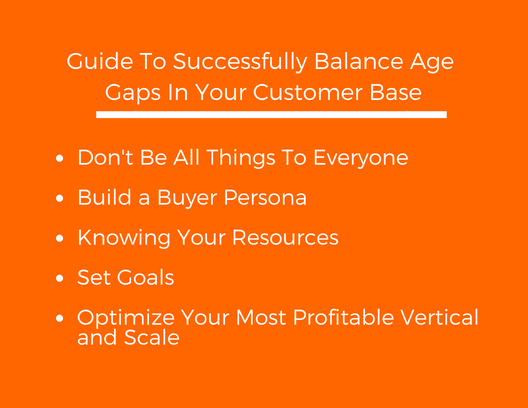 Image Courtesy: Ben Faust
Image Courtesy: Ben Faust
If you've ever gone bowling, you know that regardless of skill level, one of the hardest shots to successfully execute is when the pins are split. It requires that with with one single roll of the ball you knock down two pins located on opposites sides of the lane. Its difficult. For the novice, such as myself, it requires a lot of luck. Even for the more experienced bowler, there's a ton of skill involved. You must understand speed, the oil patterns of the lanes, angles and how the pins rebound. More often then not, the bowler is most likely to miss both pins altogether.
This is an excellent analogy for the business with two very different aged consumers. In effort to hit both with one strategy, they miss entirely. As with bowling, executing this split can be extremely challenging without the proper skill and preparation. Here's a guide to successfully balance age gaps in your customer base.
Don't Be All Things To Everyone
As business owners, it may be tempting to assume that your product or service is a perfect fit for everyone. In reality, it's not and you're doing your marketing strategy a disservice by thinking it is. When we sit with potential clients, one question we often ask is, "who is your target?". Far too often the answer is simply, everyone.
The problem is everyone doesn't make your best customer. An 19-year-old white male, History Major from L.A. with progressive politics has very little in common with a 44 year-year-old conservative Hispanic stay-at-home mother from Charleston, SC. They don't think the same. They don't act the same. They don't buy the same. More often then not, businesses think they can hit both targets with one stone. However, trying to be all things to everyone, is 100% of the time, a recipe for failure.
The truth is, there can only be one best customer for each product or service. Therefore the only way you can indeed have two different best customers is with two very different products. If you look at the top 5 selling products of all time, you'll notice that they're all clearly not for everyone and in fact, each cater to very specific audiences.
PlayStation for instance, the all time top grossing product, is a game console that clearly targets a younger male demographic. It has sold over 344 Million units worldwide and I'm sure there are people reading this that have never used one. Pfizer’s Lipitor, the #2 most sold product is prescribed to lower cholesterol and reduce the risk of heart disease. Thankfully, my cholesterol levels are in the acceptable range, in large part because I'm not yet of an age to be a good fit for this product.
You may be saying to yourself, Pfizer makes hundreds of products that appeal to many different age ranges. True, however Pfizer didn't start out that way. In 1849, cousins Charles Pfizer and Charles Erhart founded Charles Pfizer & Company, a fine chemicals company, in a red brick building, a few blocks from our offices here in Brooklyn. They made one product, Santonin. This drug expelled parasitic worms by paralyzing them, which allows them to be passed out of the body. A single solution to a very common problem especially for children living in poverty. Before they would go expand their product line they were the top US producer of the drug. They developed a team, system and processes to successfully produce and deliver the product to their existing customers.
Build a Buyer Persona
In order to build a system and process you must first understand everything about your current customer. To do so, you need to build out buyer personas. Buyer personas are the new target market. They're a semi-fictional representation of your ideal customer based on market research and real data about your existing customers. With an age gap in your customer base, you MUST develop two personas. When creating your buyer personas, consider including customer demographics, behavior patterns, motivations, and goals. Buyer personas provide vision and insight for your business. It's your compass that instructs you on where to focus your time.
Your buyer persona should be so detailed that it feels like someone you know...and you should. Give him or her a name so that everyone in the business knows who your marketing efforts are talking to and can remain focused around. This will enable you to attract the most valuable visitors, leads, and customers to your business.
Knowing Your Resources
Before you begin any marketing strategy its important to take inventory of your resources. Especially in the case of running a small business, you're unlikely to have a marketing person, let alone a team, and the sales staff is often you. Marketing is a practice that every business should be investing in, however its important to know what time, human, financial and emotional resources you can dedicate to tasks.
Consider creating a resource map. This is not only helpful for marketing but all areas of your business, especially one that is resource deficient.
Tip: Get a sheet of large chart paper and segment it into 3 column and six rows. Your columns should be for "What I Have", "What I Need" and "Next Action Steps" The rows should list the various types of resources (Social Resources/Networks, Organizational/Physical, Technological, Educational, Professional Services and Financial).
While I often encourage a paperless environment, having the physical map will be a constant reminder to you and your team about the resources at your disposal, those you need to acquire and what the next steps are in doing so. By understanding your resources, you'll have a better understanding of what you can leverage to achieve your objectives.
Set Goals
I used to roll my eyes when I would see a header like this or be told by someone to do so. However this is very important in this case. With two different buyer personas, you're likely to have very different goals for each. Its important not to merge them.
You must clearly define what success looks like for each by setting goals and benchmarks. Start by setting SMART goals (Specific, Measurable, Achievable, Realistic, and Time bound):
- Specific -- Set real numbers with real deadlines. Don't say, "I want more visitors."
- Measurable -- Make sure that you can track your goal. Don't hide behind buzzwords like "brand engagement" or "social influence."
- Attainable -- Work toward a goal that is challenging but possible. Don't try to take over the world in one night.
- Realistic -- Be honest with yourself, because you know what you and your team are capable of. Don't forget any hurdles you may have to overcome.
- Time-bound -- Give yourself a deadline. Don't keep pushing towards a goal you might hit "some day."
Optimize Your Most Profitable Vertical and Scale
Scale is often been confused with growth but here it's important to note the distinction. Scale is a type of growth that is responsible, proportional and profitable. Companies can grow too fast and often fail without the right scalable and repeatable process. Scaling suggest that you perfect the business model with one product optimizing it for a single audience, commonly referred to as a vertical, before introducing additional verticals. By doing so, you can replicate the established blueprint and quickly double the output while exponentially growing revenue. All you have to do is follow the previously successful model.
To scale a business with two different verticals, first determine which is most profitable and concentrate all your efforts towards optimizing that persona. Dedicate all you resources towards making this vertical successful. While it can be tempting to experiment with several things at once, stick to one change at a time. This is key. Using this scientific method you can see how small changes impact the business.
Once you know which strings to pull, make sure to take notes and viola! You have a scalable process. Don't get frustrated, this may take some time as you'll have to tweek and give your test time to produce results that you can measure and analyze. There's no handbook for your business, but you're developing one through trial and error. Understand that you may see a fall off in your other vertical. It's important however to remain focused. Having a sustainable product and service line built for the long run will be worth small declines. In the end, you'll be able to apply the same process with the other vertical and now have both running like a well oiled machine.
Liked what you read? Please comment and share!
Share this
You May Also Like
These Related Stories

Establishing Pricing Tier Based Buyer Personas

6 Best Practices For Small Business Social Media Marketing




